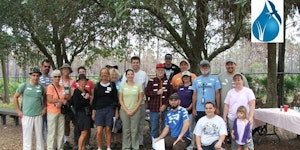Bird Rookery Swamp observations
Saturday, November 14
6:25 am-1:05 pm
“There were all sorts of surprises on the tram. The first was a small flock of Robins that flew into the trees to the west of the gravel path; it was good to see them back. Later, a visitor said he saw another larger flock near marker 5.
Another surprise was the huge number of White Ibis that flew into the trees around the parking lot pond a little before sunrise. They just
kept coming, wave after wave. The total number of individual ibis for the day was 261, and all but nine of those were in that pre-dawn arrival.
 One more surprise was how few gators were present, even into the early afternoon. Ida was in her pond in the afternoon, resting in the water by the culvert (left photo).
One more surprise was how few gators were present, even into the early afternoon. Ida was in her pond in the afternoon, resting in the water by the culvert (left photo).
Water levels have dropped along the tram — there are only two spots between markers 6 and 3 where walking through the water is still necessary.
Nineteen species of butterflies was also a bit unusual considering the wind. Nine of those species were the little grass skippers who stayed very close to the ground or on Alligator Flag leaves when the sun hit them. One new butterfly species for me was a Fulvous Hairstreak.
The biggest surprise was when I almost stepped on a 3-12 to 4 foot
Water Moccasin in the thigh-high grasses. Each of us was startled and
retreated a bit. A photo of the snake showing his displeasure at being
disturbed is attached.

BIRDS
Pied-billed Grebe – 3
Anhinga – 15
Great Blue Heron – 7
Great Egret – 10
Little Blue Heron – 22
Tri-colored Heron – 3
Green Heron – 4
Black-crowned Night Heron – 8
White Ibis – 261
Wood Stork – 3
Black Vulture – 14
Turkey Vulture – 39
Red-shouldered Hawk – 14
American Kestrel – 1
Limpkin – 1
Belted Kingfisher – 12
Red-bellied Woodpecker – 16
Downy Woodpecker – 1
Pileated Woodpecker – 4
Eastern Phoebe – 10
Blue Jay – 2
American Crow – 5
Tufted Titmouse – 6
Blue-gray Gnatcatcher – 32
American Robin – 8
Gray Catbird – 13
Loggerhead Shrike – 1
Black-and-white Warbler – 1
Yellow-throated Warbler – 1
Palm Warbler – 8
Common Yellowthroat – 2
Northern Cardinal – 3
Common Grackle – 65
BUTTERFLIES
Palamedes Swallowtail – 2
Tiger Swallowtail – 7
Spicebush Swallowtail – 1
Ruddy Daggerwing – 2
Gulf Fritillary – 1
White Peacock – 153
Red Admiral – 1
Viceroy – 2
Phaon Crescent – 4
Fulvous Hairstreak – 1
Barred Yellow – 74
Dorantes Longtail – 2
Brazilian Skipper – 23
Eufala Skipper – 3
Least Skipper – 1
Three-spotted Skipper – 3
Twin Spot Skipper – 5
Tropical Checker – 5
unknown skipper – 1
DRAGONFLIES/DAMSELFLIES
Eastern Pondhawk – 12
Needham’s Skimmer – 1
Blue Dasher – 2
Regal Darner – 1
MAMMALS
Gray Squirrel – 1
Raccoon – 1
REPTILES/AMPHIBIANS
Alligator – 21
Brown Anole – 2
Green Anole – 1
Water Moccasin – 1
Green Treefrog – 1
By Dick Brewer









 foraging in the Pickerelweed to the east of the gravel path leading to the boardwalk. A photo with one adult and three of the juveniles in the family is attached. Also had two Pied-billed Grebes in one of the large open water areas between markers 6 & 3.
foraging in the Pickerelweed to the east of the gravel path leading to the boardwalk. A photo with one adult and three of the juveniles in the family is attached. Also had two Pied-billed Grebes in one of the large open water areas between markers 6 & 3.



 geocaching heroes—Milla Voellinger, Pete Corradino and others for a great day of geocaching at the CREW Cypress Dome Trails. They will give introductory lessons to newbies, send experienced cachers out with new cachers, or simply get you started and send you out on your own if you’d like. Whatever your pleasure, these geocaching heroes can help you learn to love this high-tech treasure hunting the woods.
geocaching heroes—Milla Voellinger, Pete Corradino and others for a great day of geocaching at the CREW Cypress Dome Trails. They will give introductory lessons to newbies, send experienced cachers out with new cachers, or simply get you started and send you out on your own if you’d like. Whatever your pleasure, these geocaching heroes can help you learn to love this high-tech treasure hunting the woods.








 Join CREW on “Saturday Oct. 24 at Riverside Park in the historic, downtown district of Bonita Springs on Old U.S. 41 and Pennsylvania Avenue. Hosted by the City of Bonita Springs, the event will include live entertainment, a cornhole tournament, hayrides, a pumpkin patch, petting zoo, and the popular fish fry. Festivities also include the traditional Imperial River Challenge featuring canoe and kayak races, pumpkin decorating contest, and the children’s rubber duck race. Kids will enjoy the petting zoo, pony rides, and to pick their very own pumpkin from a pumpkin patch after a free hayride!
Join CREW on “Saturday Oct. 24 at Riverside Park in the historic, downtown district of Bonita Springs on Old U.S. 41 and Pennsylvania Avenue. Hosted by the City of Bonita Springs, the event will include live entertainment, a cornhole tournament, hayrides, a pumpkin patch, petting zoo, and the popular fish fry. Festivities also include the traditional Imperial River Challenge featuring canoe and kayak races, pumpkin decorating contest, and the children’s rubber duck race. Kids will enjoy the petting zoo, pony rides, and to pick their very own pumpkin from a pumpkin patch after a free hayride!
